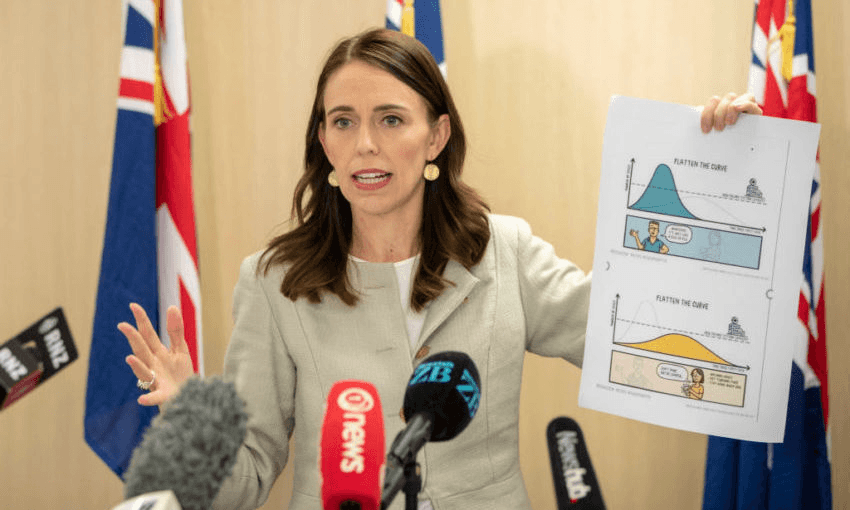As New Zealand enters its third week of Covid-19 lockdown, a just-released set of modelling provides a flare of light at the end of the tunnel, reports Toby Manhire.
On a day in which the active case number decreased, new analysis finds that “while New Zealand case numbers remain low, tracing, testing, and rapid case isolation, combined with population-wide control methods, offer an opportunity for the country to contain and eliminate Covid-19.”
Jacinda Ardern previewed the set of modelling, by scientists at Te Pūnaha Matatini, at her briefing earlier today, saying it suggested New Zealand is on track to “meet their most optimistic scenario”.
She added: “Instead of the horrific scenes we have seen abroad, we are at 1,239 cases, and the total number of cases has fallen for the last four days with 29 new cases today, the lowest daily number of cases since March 23, before the lockdown began. We are turning a corner, and your commitment means our plan is working.”
Simulations using the model suggest the current alert level four controls had substantially suppressed the number of cases.
The new research showed “the measures are working better than we would have expected two weeks ago”, said Shaun Hendy of Te Pūnaha Matatini. “We’re really pleased and impressed, and on track to eliminate if we hang in there and stick to it.”
The models offered both “pessimistic and optimistic answers” to the question of whether the current measures and trajectory would mean New Zealand could move out of alert level four in a fortnight, Hendy told The Spinoff.
“Probably there are parts of the country where we are able to lift lockdown and parts where we won’t want to.”
He added: “In the bigger centres where we have those large clusters we may need to hang in there longer.”
There are 12 “significant clusters”, as classified by the Ministry of Health. The three biggest are in Auckland, linked to Marist College, Matamata and Bluff.
At today’s briefing, the director general of health, Ashley Bloomfield, said: “We take a particular interest in clusters that occur in a place, at an event, workplace or school. Any cluster has the potential for rapid spread. Our intention for any cluster is to ring-fence it and stop any spread.”
The announcements today, at the halfway point in the four-week lockdown, were encouraging, with 29 new cases, and a net decrease in active cases. “If we stick to what we’re doing we’re going to be the first country in the world to eliminate,” said Hendy.
Using a stochastic model, which is able to take into account the random behaviour of an epidemic, Te Pūnaha Matatini plugged in a range of variables to estimate and plot optimistic, pessimistic and realistic scenarios. The findings underscore the importance of combining fast isolation of cases, effective contact tracing and rapid testing in pursuing an elimination strategy.
The scientists further suggest that “different testing strategies (eg testing of essential services personnel with high numbers of contacts) followed by case isolation and contact tracing should also be considered as an additional control measure. New technologies that allow for faster contact tracing or testing should also be investigated. Improving the speed at which cases are isolated, by testing, tracing, or otherwise, will increase the chance of containment and elimination.”
They noted: “It is important to stress the limitations of the model for assessing long-term impacts. Further versions of this model will include an age-structured population with the possibility that contact rates between age groups or other demographic groupings could be differentially affected by specific control interventions. It will be important to consider the effects of geographic dispersion and contact network structure. This will allow for investigation of regional containment combined with inter-regional travel restrictions, selective reopening of schools and businesses, and potential harms to at risk communities and essential workers.”
The models offer a dramatically rosier picture than the worst-case scenario put forward in separate modelling for the Ministry of Health over a fortnight ago. Based on the failure of any elimination strategy and the undetected spread since early last month, that scenario modelled an outbreak peaking in early July 2020, with 3.32 million New Zealanders getting symptomatic illness, 146,000 sick enough to require hospital admission and 27,600 people dying.
Hendy said the team at Te Pūnaha Matatini, a Centre of Research Excellence based at the University of Auckland, had been working around the clock on the new analysis. “In addition to getting this paper out, we’ve been running lots of scenarios for the government, to help them have confidence in the decision making.”

